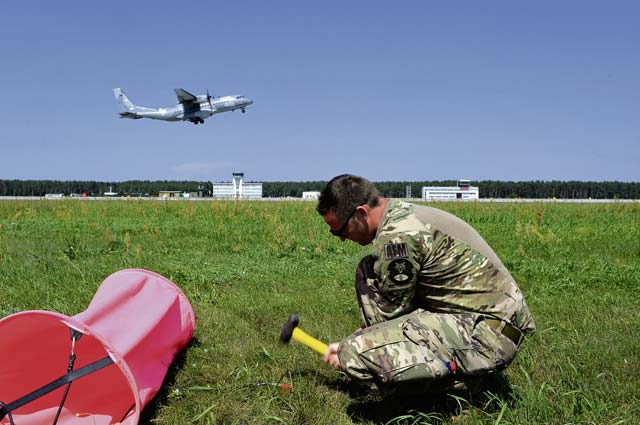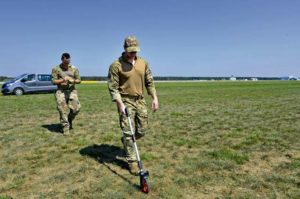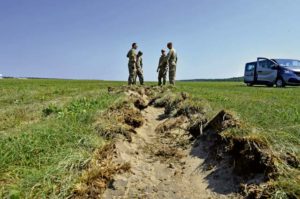
POWIDZ AIR BASE, Poland — The summer sun beat down upon the grass field at Powidz Air Base, Poland; the never-ending waves of scorching heat could have mummified anyone foolhardy enough to soak in the sunlight beneath the empty, cloudless sky.
But there was a motley crew who might have been willing to do just that: five Airmen sped down the sea of grass in their blue-gray van, galloping over the hills and bumping along the way.
“You think it’s gonna be just as hot today like it was yesterday?” the driver asked his partner in the passenger seat.
“They say it’s supposed to be even hotter today,” responded the other. “Hope you brought lots of water.”

The Airmen hail from the 435th Contingency Response Group on Ramstein Air Base. They were in Poland to support a bilateral exercise between the U.S. and Polish air forces.
The crew’s mission was to establish zones where aircraft can drop supply packages and make dirt landings. While each member of the crew has his own specialty and trade, they worked together to make the mission possible.
They were also coming out to support Polish air force troops establishing their own landing operations.
“What we’re doing out here right now is verifying a site we previously surveyed,” said U.S. Air Force Tech. Sgt. Laramie Combs, a contingency response airfield manager. “Our job is to establish landing zones and drop zones in austere environments. We have here a plot of land approximately seven thousand feet long and 180 feet wide; theoretically we could cut it up into several different LZs.
“We truly are the first ones in and we stay until the case is established,” he continued, whacking away at a stowaway wasp with a plastic bottle. “The LZ or DZ is the first thing that goes up, and then you get your combat communications.”
Music was blaring on the stereo, the air conditioning was on full blast, and the crew was enjoying the ride. They were comfortable— for now.
The Airmen parked their van next to the Polish LZ crew they were helping and exited the comfort of their van. The two groups talked a little bit and got acquainted.
“Well, let us know if you guys need anything,” Combs said to his Polish friends.
Then turning to his crew he said, “We’ll get started on the site survey once these guys finish up.”
The LZ crew would be waiting for a while. A Polish C-295 aircraft approached, and performed what seemed to be an endless repetition of touch-and-go landings, low passes, and dirt landings — leaving a cloud of dust with each pass.
“It sure is hot out here,” said U.S. Air Force Tech. Sgt. Joshua Todd, a weather Airman who is certified on DZ operations. He poured some water onto his hair, and rubbed his face with the waterfalls running down his forehead.
There could be a lot of waiting on the LZ. This opens up plenty of time to tell stories, crack jokes, and play games.
U.S. Air Force Tech. Sgt. Joshua McIntosh, an air traffic controller, was a paradox — eating healthy and loving to work out, but also enjoying tobacco.
“We can play Thor’s Hammer,” McIntosh said. “Shove a knife into the dirt and throw hammers at it. First one to knock the knife over wins.”
McIntosh’s task was to visually scan the area to ensure the landing zone was safe for aircraft operations, coordinate with the local air traffic control tower for airspace deconfliction, and issue clearances to aircraft for approaches and departures.
After what seemed like ages in limbo, the C-295 completed its passes and the Polish LZ crew rolled out.
“Alright, let’s get started,” said U.S. Air Force Staff Sgt. David Anderson, a contingency response engineering supervisor. He was also the driver of the van.
“It’s time to drop the hammer!” he said, and opened the back door of the van to retrieve what looked like a long stainless steel pole with a gigantic metallic weight which slid up and down the pole.
“This is a dynamic cone penetrometer,” Anderson continued. “It measures the potential bearing capacity of the ground. This is one of the first steps in preparing an LZ.”
“The ground can be deceitful,” Combs added. “Soil can be rock-hard on top, but soft a few inches below. It can also be the other way around. I set up an LZ in the desert one time, and when the plane touched down, the ground beneath it just turned into moon dust. That LZ was finished.”
Anderson handed the device to Todd, and the latter drove it into the ground. Anderson opened a laptop computer which he used to gather the data generated by the penetrometer.
“Ready? OK go,” he told Todd. Todd lifted the weight up to the top of the pole and then dropped it, letting the weight make a loud clanging sound at the bottom.

“Do it again,” Anderson, staring at the computer screen.
Clang!
“Again.”
Clang!
“And one more time.”
Clang!
Todd’s veins popped out of his arm with each repetition.
Anderson and Todd repeated the process, with the penetrometer sounding like a church bell ringing and the metal pole thrusting deeper into the ground with each drop of the weight. They did this around different areas of the LZ.
Meanwhile, Combs and his colleague of the same trade, U.S. Air Force Staff Sgt. Matthew Montgomery, were setting up panels for a makeshift runway. 10 panels were needed for one LZ.
The two took turns hammering the stakes of a panel into the ground, then Montgomery picked up what looked like a rod on wheels.
“This is a measuring wheel,” Montgomery said. “You set the wheel on the ground and it calculates the distance you walk.”
Montgomery used the measuring wheel to measure the distance required between two runway panels. When he stopped at the perfect distance, he and Combs hammered a panel directly across from the previous one.
They finished the first few panels and looked back at their work.
“Hey, looks like we need to fix that panel in the back,” said Combs, wiping the sweat off his forehead. “What do you think Montgomery?”
“Looks like it, or maybe we’re getting delirious in this heat,” Montgomery replied laughing a little. He poured some water over his face, and drank some as well.
“We can fix it on the way back after we finish the last two panels,” he added.
They continued hammering away at the stakes as Polish aircraft conducted touch-and-go landings on the paved runway nearby.
“You don’t get to do this job as a normal Air Force airfield manager,” Combs said. “You’d be stuck in an office behind a computer. Out here, we get our hands on everything. I was supposed to finish up my enlistment and get out, but I stayed in when they offered me this position.”
“I’d reenlist just to keep doing this,” Montgomery added.
Both Montgomery and Combs lay claim to the honor of part of an extremely small number of contingency response airfield managers in the Air Force. Whenever a slot opens for the job, it’s not long before it’s taken, Combs added.
“Well, that does it,” Combs said, driving in the last stake. “We’ll just fix that other panel in the back and call it a day.”
The two met up with the rest of their team just as the latter had finished making their load-bearing assessments of the ground. Anderson was packing the DCP into the trunk of the van while McIntosh snacked on a cucumber in the backseat with the air-conditioning blasting away at his face.
The crew hopped into the van, turned up the radio, and rode off — back to their headquarters building.
Rock n’ roll music from the 1980s blared through the stereo.
“So now the LZ is ready for tonight,” Combs said, enjoying the air conditioning. “I’m hungry; let’s get some food… and a bath.”


